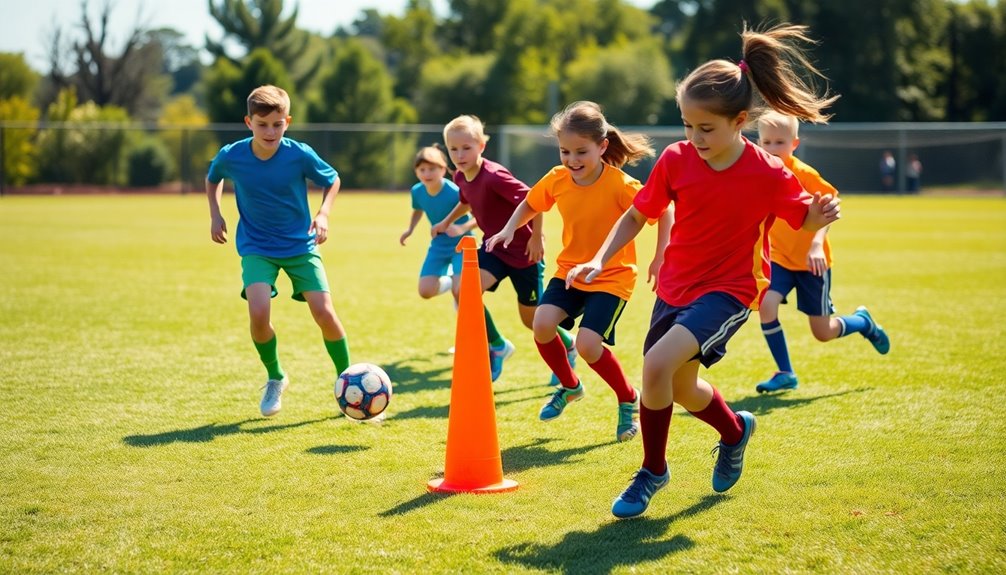
First Touch Soccer Drills to Build Confidence on the Field
February 1, 2025To build confidence on the field, focus on first touch soccer drills that enhance your ball control and awareness. Start with toe taps and inside-outside touches to boost sensitivity and quick footwork. Juggling, particularly with tennis balls, improves your overall touch and coordination. Incorporate mental drills that sharpen your decision-making under pressure, such as reacting to color cues while dribbling. Always warm up to prepare physically and cognitively, ensuring you're game-ready. As you master these techniques, you'll notice significant improvements in your confidence and performance. There's even more to explore for elevating your game.
Importance of First Touch
The importance of your first touch in soccer can't be overstated; it can make or break your game. A well-executed first touch greatly influences your control of the ball, helping you maintain possession and reduce turnover rates by up to 30%.
When you master this skill, you can quickly shift from receiving the ball to making decisive plays, which is essential in tight spaces. A positive first touch not only sets you up for effective passing and receiving but also creates scoring opportunities. Improving your first touch will allow you to execute tricks like the step-over to outmaneuver defenders effectively. Mastering techniques like the Nutmeg can also help you evade opponents and maintain attacking momentum.
With a better first touch, you can take quicker shots on goal and position yourself effectively for subsequent passes. This ability to control the ball under pressure enhances your overall performance and contributes to higher participation in offensive plays.
To improve your first touch, practice drills that involve receiving the ball with different parts of your body. These exercises build muscle memory and boost your confidence during intense game situations. Additionally, developing your passing accuracy can further enhance your first touch skills and overall game effectiveness.
Cognitive Skills in Soccer
Incorporating cognitive challenges into your training can dramatically improve your decision-making on the field. By engaging in mental drills, you sharpen your awareness and reaction time, which are essential for effective gameplay. Additionally, mental training techniques like visualization can enhance your cognitive skills during high-pressure situations. Emphasizing these cognitive skills not only boosts your confidence but also enhances your team's communication and dynamics during matches. Furthermore, regularly practicing tactical awareness can greatly improve your ability to make strategic decisions under pressure. Additionally, incorporating reaction training can further enhance your decision-making and response time in high-pressure situations.
Mental Drills Importance
Mental drills play a crucial role in developing cognitive skills that enhance your performance on the soccer field. By incorporating mental drills into your training sessions, you can greatly improve your first touch and overall game awareness. These cognitive challenges, like recognizing colors while dribbling, sharpen your mental processing speed, allowing you to react faster during matches.
Engaging in brain games as part of your training routine not only enhances your mental acuity but also complements your physical skills. This balanced development is essential for success in soccer, as it fosters a deeper understanding of the game dynamics.
As you practice cognitive elements consistently, you'll notice an increase in your situational awareness and confidence on the field. Additionally, continuous mental training helps you become more aware of your surroundings, leading to better decision-making during gameplay.
When you integrate mental drills into your regimen, you're not just enhancing your physical abilities; you're building a foundation of cognitive skills that will elevate your performance. So, make mental drills a priority in your training sessions to access your full potential on the soccer field.
Decision-Making Enhancement
Improving your decision-making on the soccer field is essential for elevating your game. By incorporating mental drills during practice, you'll enhance your ability to make quicker and more effective choices when it counts.
Decision-making enhancement comes from engaging in specific drills that sharpen your cognitive skills and boost overall performance under pressure.
Try simple passing drills that emphasize awareness of your surroundings. These exercises help you develop better spatial understanding, allowing you to anticipate opponents' moves and react accordingly.
Additionally, partner drills that require quick reactions to visual stimuli foster adaptability, improving your ability to make split-second decisions during gameplay.
Continuous repetition of these decision-making drills is key. The more you practice, the more naturally you'll process visual cues on the field.
This means when it's time to pass the ball, you'll know exactly where to place it and when to make the move. Remember, a well-timed pass can change the game's momentum.
Focus on these cognitive aspects, and you'll find that your decision-making skills will greatly enhance your overall performance, giving you the confidence to excel during matches.
Cognitive Challenges Benefits
Cognitive challenges in soccer drills offer a significant boost to your game, enhancing your ability to make swift and informed decisions on the field. By integrating these challenges into your training, you'll improve your cognitive processing, which leads to sharper awareness of your surroundings.
For instance, drills that require color recognition while dribbling force you to think quickly and adapt to dynamic situations, making sure you're always a step ahead of your opponents.
Engaging in mental drills alongside your physical training promotes balanced development, allowing you to refine both your technical skills and mental acuity. This combination is essential for elevating your overall performance.
Continuous repetition of cognitive-focused exercises not only sharpens your mental skills but also builds your confidence in executing complex plays during matches.
Moreover, adopting German and European coaching philosophies, which emphasize brain games in training, can help you become a really good player.
When you challenge your mind as much as your body, you prepare yourself for the unpredictable nature of soccer, ensuring you can respond effectively when it matters most.
Embrace these cognitive challenges, and watch your game soar!
Effective Warm-Up Techniques
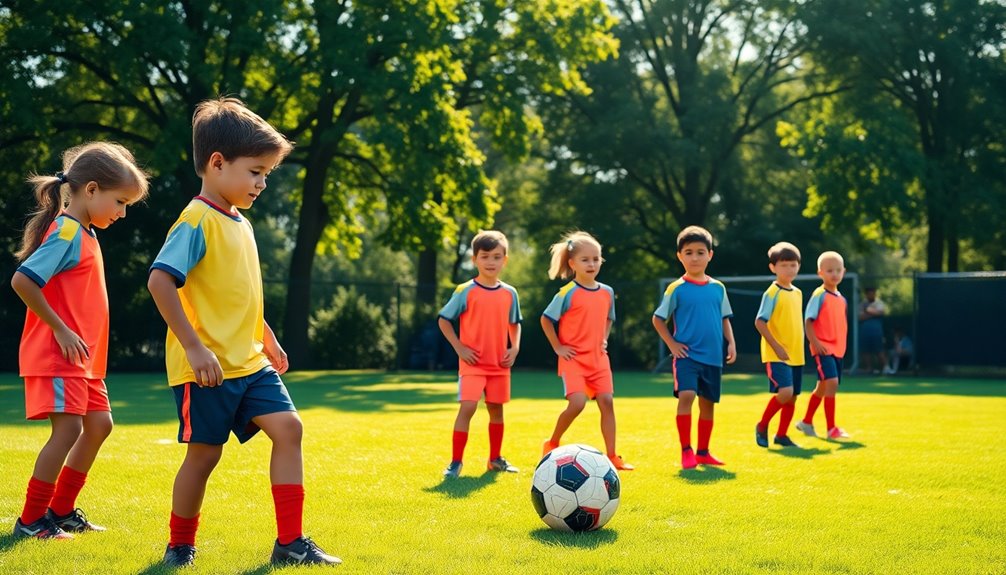
A solid warm-up routine is crucial for any soccer player looking to enhance performance and reduce injury risk. Start with a 10-minute session focusing on dynamic stretches and movements. High knees and butt kicks are great exercises to get your muscles activated and ready for action. By incorporating these specific drills, you'll greatly lower your chances of injury during training or matches.
As you pass the ball around with teammates, engage in muscle activation drills to improve flexibility and range of motion. This not only prepares your body physically but also sharpens your mind. Incorporating long-distance running into your warm-up can further enhance your cardiovascular endurance, setting a strong foundation for performance. A well-rounded warm-up can also include dynamic warm-up exercises that mimic soccer-specific actions, enhancing your mental readiness. Additionally, integrating endurance training methods into your routine can significantly boost your overall fitness level.
A well-structured warm-up routine can include cognitive elements, helping you make quicker decisions on the field. Consistency is key; sticking to your warm-up routine will contribute to your long-term fitness and endurance.
When you take the time to properly warm up, you'll find that you can come back stronger during each game. So, don't skip this crucial step—embrace it as part of your preparation, and watch your performance levels soar!
Ball Mastery Exercises
These drills are essential for enhancing your ball control and developing touch sensitivity. By consistently practicing, you build a solid foundation for advanced skills and improve your overall situational awareness on the field. Understanding basic rules can also help you make better decisions during gameplay. Incorporating moves like the Cruyff Turn can further enhance your ability to navigate tight spaces during gameplay. Additionally, mastering ball control is crucial for players in every position, from goalkeepers to forwards.
Here are four effective ball mastery exercises you can incorporate into your training:
- Toe Taps: Lightly tap the top of the ball with the soles of your feet while keeping your head up. This helps with touch sensitivity and ball control.
- Inside-Outside Touch: Use the inside and outside of your foot to touch the ball back and forth. This exercise boosts your skill development and encourages quick footwork.
- Juggling: Start by juggling the ball with your feet and thighs to enhance your touch and control. Challenge yourself with different body parts as you improve.
- Wall Pass: Pass the ball against a wall and receive it back, focusing on maintaining a soft touch. This drill sharpens your ball control and encourages head-up play.
Juggling With Tennis Balls
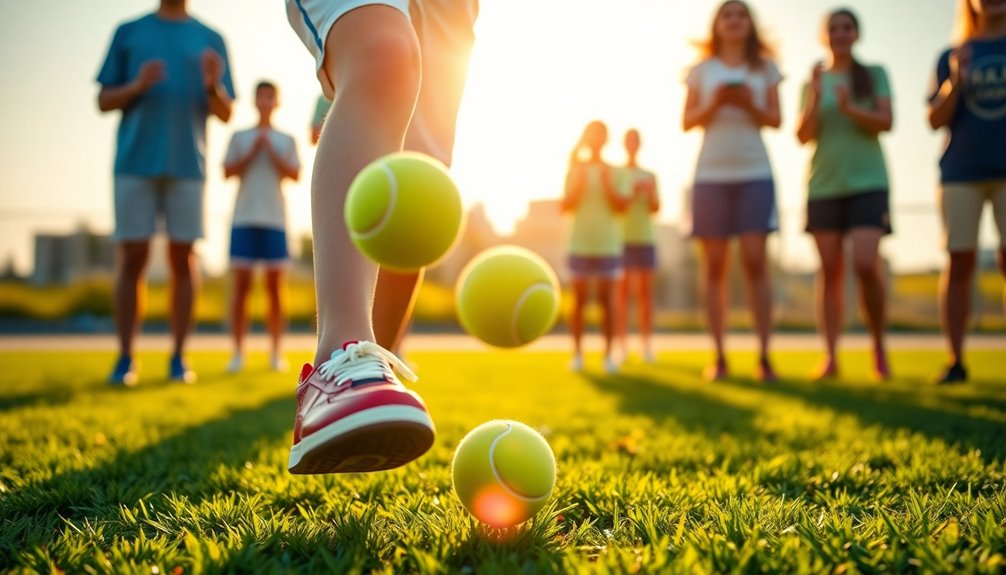
Juggling with tennis balls can take your ball control to the next level. The smaller size of tennis balls challenges you to refine your ball handling skills, leading to significant coordination improvement. As you practice, you'll notice the juggling benefits—improved focus and concentration that enhance your awareness on the field. Incorporating agility drills into your training regimen can further enhance your ability to respond quickly during gameplay. Additionally, these drills help develop speed and agility which are crucial for on-field performance.
Start with basic tennis ball techniques, such as alternating touches between your feet and thighs. This foundational practice builds the necessary touch and juggling skills for effective first touch during gameplay.
Regularly incorporating resistance band exercises while juggling can further promote stability and prevent injuries, ensuring you maintain peak performance.
As you progress, aim for higher juggling counts and more complex patterns to boost your confidence on the field. You'll find that the skills you develop through juggling translate directly to better handling of a football. Additionally, practicing close ball control while juggling reinforces your ability to maneuver effectively in tight spaces during matches.
Dribbling Drills for Confidence
Dribbling drills are essential for building confidence on the field and enhancing your overall ball control. Mastering effective dribbling techniques not only improves your skills but also boosts your spatial awareness during matches.
Here are four focused drills to help you gain confidence:
- Cone Dribbling: Set up cones in a straight line and dribble through them while keeping your head up. This helps develop spatial awareness and control.
- Color Recognition Drills: Assign colors to specific cones and call them out as you dribble. This enhances cognitive processing and decision-making under pressure.
- Partner Reaction Drills: Work with a partner who gives visual cues. Reacting to these cues will improve your agility and confidence in unpredictable game situations.
- Quick Touch Dribbling: Focus on making quick touches and passes while dribbling. This keeps the ball close and fosters a sense of control in tight spaces.
Incorporating these drills into your practice routine won't only enhance your dribbling techniques but also greatly contribute to your confidence building on the field.
Passing Techniques to Enhance Control
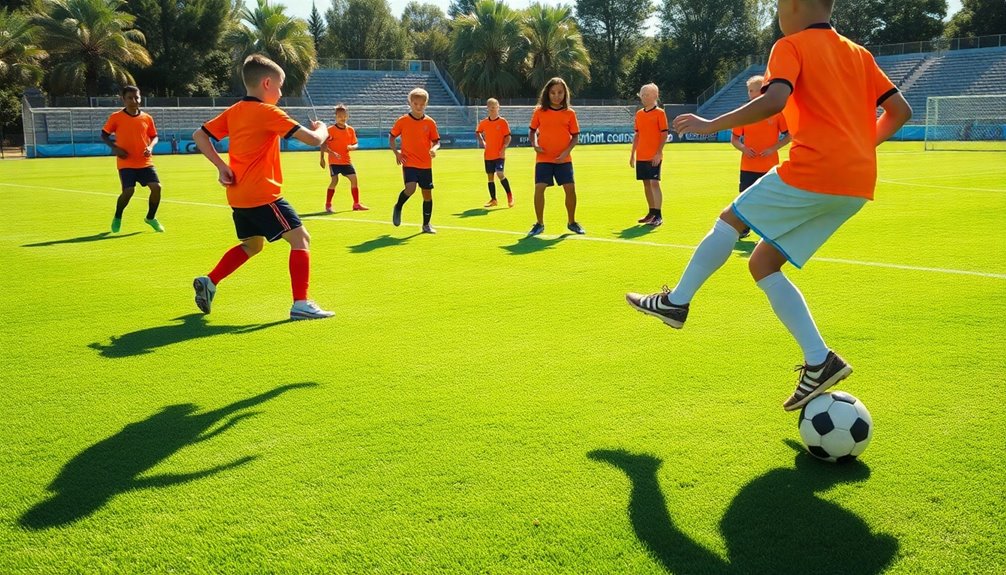
To elevate your passing game, it's vital to focus on techniques that enhance control and precision. Start by emphasizing the use of your back foot for receiving the ball and your near foot for executing passes. This technique is particularly effective for wingers when making diagonal passes, ensuring accuracy and improving your overall passing efficiency.
Incorporate passing drills that minimize time spent on the ball. Quick touch and pass exercises not only sharpen your skills but also build confidence in tight situations. Partner drills that react to visual cues can further improve your passing accuracy, allowing you to develop both your technical ability and cognitive processing under pressure.
Try practicing with smaller objects, like a tennis ball, to increase focus and enhance your ball mastery. This approach helps you refine your control techniques while boosting your confidence on the field.
Additionally, engage in ball mastery drills that encourage you to keep your head up, fostering better awareness of your surroundings. This awareness is vital for executing precision passing and enhancing your overall game.
Reaction Time and Decision Making
Quick thinking and sharp reactions are essential skills in soccer, directly impacting your performance on the field. To enhance your reaction time and decision-making, consider incorporating the following drills into your training routine:
- Partner Reaction Drills: Work with a teammate to respond to visual cues, such as colored cones or hand signals, to develop your ability to make quick decisions.
- Cognitive Challenge Dribbling: As you dribble, call out colors or numbers displayed on cones. This boosts your cognitive processing and allows for faster reactions under pressure.
- Cone Dribbling with a Head-Up Posture: Maneuvering through cones while keeping your head up improves your ball control and situational awareness, key for effective decision-making.
- Quick Touch Passing: Focus on minimizing the time spent on the ball with quick touches and passes. This drill sharpens your ability to make split-second decisions during gameplay.
Incorporating Mental Training
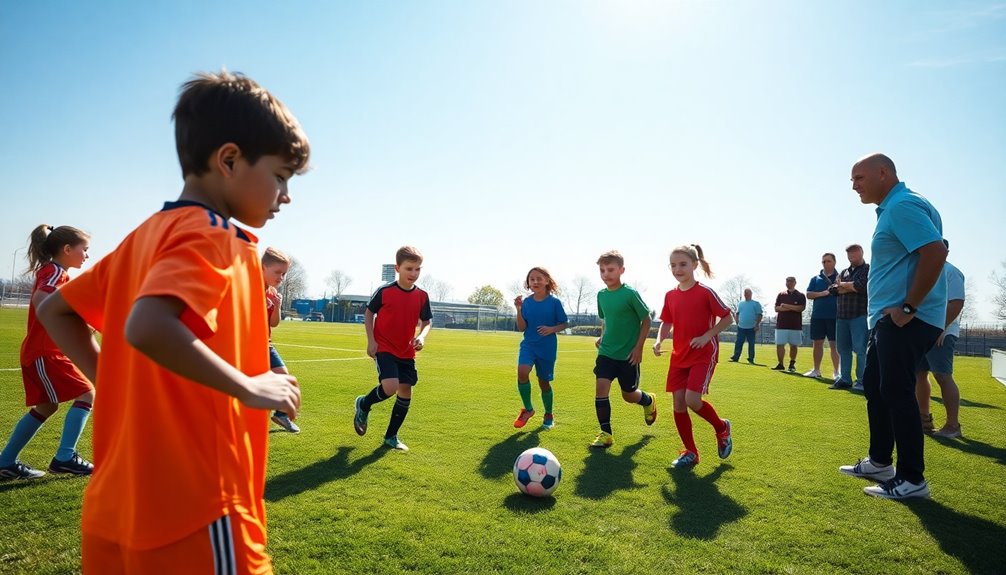
Incorporating mental training into your soccer practice can greatly elevate your first touch skills and overall gameplay. By integrating mental game strategies, you enhance your decision-making capabilities on the field. For example, using cognitive training methods like color recognition during dribbling drills sharpens your mental acuity, allowing you to react more effectively in real-game situations.
Continuous practice of both mental and physical drills builds better muscle memory, enabling you to execute first touches with greater confidence and precision under pressure. Coaches from German and European philosophies advocate for brain games in training, emphasizing their role in boosting cognitive processing skills while performing technical tasks.
Visualization techniques can also play an essential role in your development. Picture yourself in various game scenarios, focusing on your first touch and decision-making. This mental rehearsal prepares your mind for actual gameplay, reinforcing your skills.
Balancing physical training with these cognitive elements not only enhances your first touch but fosters a deeper understanding of game dynamics. Ultimately, this thorough approach leads to improved performance on the field.
Injury Prevention Strategies
Starting your training with a consistent warm-up routine can greatly reduce the risk of injuries. This 10-minute routine should include dynamic stretches to activate muscle fibers and prepare your body for the demands of the game.
Remember, proper injury assessment and recovery strategies are essential for maintaining peak performance.
Here are four effective injury prevention strategies to incorporate into your warm-up:
- Dynamic Stretching: Engage in exercises that increase your range of motion and blood flow to muscles.
- Resistance Band Exercises: Use bands to strengthen supporting muscles, promoting stability and reducing injury risks.
- Ball Mastery Drills: Practice juggling or using a tennis ball to enhance your coordination and control, helping prevent injuries caused by poor technique.
- Gradual Intensity Increase: Slowly ramp up the intensity of your training sessions, allowing your body to adapt and minimizing the likelihood of strains and sprains.
Additionally, focus on maintaining a head-up posture while dribbling. This improves your balance and awareness on the field, further contributing to injury prevention.
Prioritize these strategies to stay healthy and confident in your game!
Future Drill Progressions
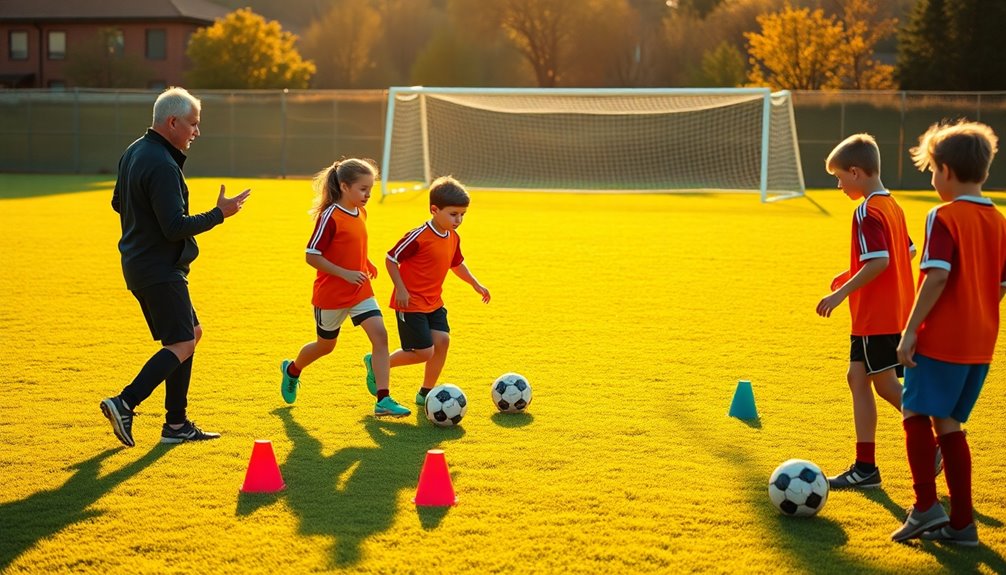
To enhance your first touch and overall gameplay, future drill progressions should blend skill development with cognitive challenges. Start by incorporating drill variations that use different object sizes, like a tennis ball. This approach sharpens your focus and improves your first touch control when you shift back to a standard football.
Next, introduce partner drills that emphasize quick reactions to visual cues. These drills will help you develop a more instinctive first touch in dynamic game situations. Incorporating cognitive challenges, such as color recognition during dribbling, can sharpen your decision-making skills and boost your confidence.
As you progress, gradually increase the complexity of your drills. Shift from basic ball mastery to more advanced passing and shooting exercises, ensuring you experience consistent skill progression. This gradual escalation builds your confidence over time.
Finally, consistently integrate reaction techniques and head-up play into your training sessions. This will prepare you for real-game situations, fostering greater player adaptability.
Engaging With the Soccer Community
Engaging with the soccer community opens doors to invaluable player development opportunities. By connecting with others, you can enhance your skills and gain insights that help you grow.
Here are four effective community engagement strategies to contemplate:
- Join Local Clubs and Leagues: Participating in these settings exposes you to diverse coaching styles and player backgrounds, enriching your experience.
- Utilize Social Media: Platforms like Twitter and Instagram can help you connect with fellow players and coaches. You'll find a wealth of training drills and strategies shared by others.
- Attend Workshops and Clinics: These events provide networking opportunities benefits, allowing you to learn from experienced coaches and professionals in a focused environment.
- Encourage Interaction: Engaging with training videos through likes, subscriptions, and feedback fosters a supportive community. This collaborative learning environment motivates everyone to continuously improve.
Conclusion
By focusing on first touch drills, you're not just enhancing your skills—you're igniting a passion for the game that could light up the entire field! Trust in your abilities, embrace the challenges, and remember that every touch you practice builds confidence and sharpens your game. Keep pushing yourself, connect with fellow players, and watch as your love for soccer transforms you into a player who truly shines. Get out there and make every touch count!


